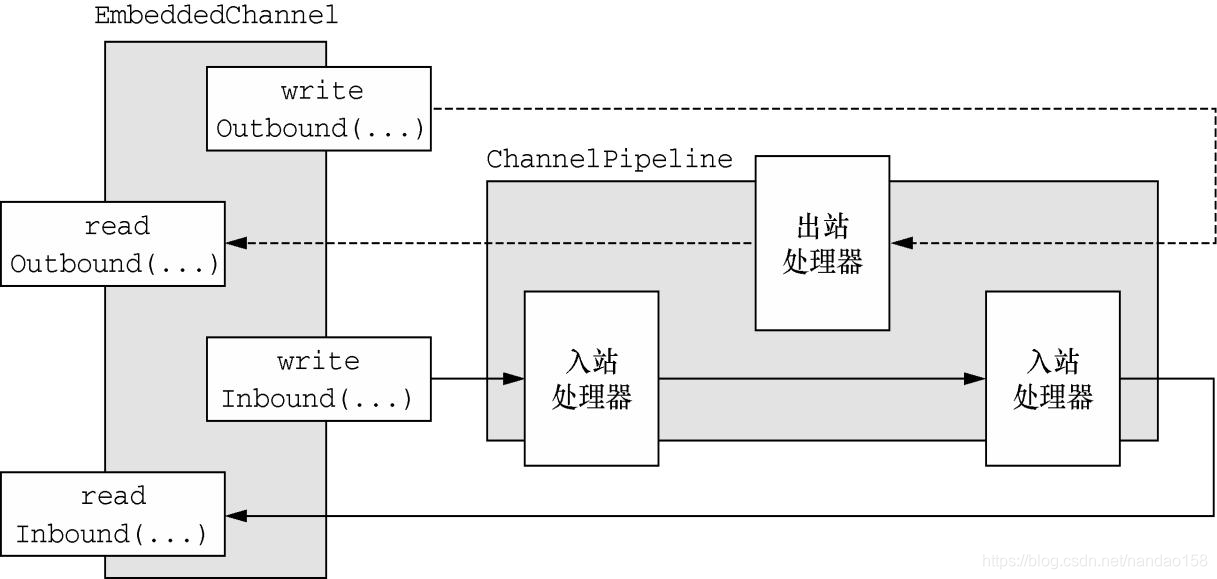今天分享 Netty 单元测试解决方案
一种特殊的
Channel
实现——
EmbeddedChannel
,它是
Netty
专门为改进针对ChannelHandler 的单元测试而提供的。将入站数据或者出站数据写入到 EmbeddedChannel
中,然后检查是否有任何东西到达了 ChannelPipeline
的尾端。以这种方式,你便可以确定消息是否已经被编码或者被解码过了,以及是否触发了任何的 ChannelHandler
动作。
writeInbound(Object... msgs)
将入站消息写到
EmbeddedChannel
中。
如果
可以通过
readInbound()
方法从EmbeddedChannel 中读取数据,则返回
true
readInbound()
从
EmbeddedChannel
中读取一个入站消息。任何返回的东西都穿越了整个ChannelPipeline。
如果
没有任何可供读取的,则返回
null
writeOutbound(Object... msgs)
将出站消息写到
EmbeddedChannel
中。
如果
现在可以通过
readOutbound()
方法从EmbeddedChannel 中读取到什么东西,则返回
true
readOutbound()
从
EmbeddedChannel
中读取一个出站消息。任何返回的东西都穿越了整个ChannelPipeline。如果没有任何可供读取的,则返回
null
finish()
将
EmbeddedChannel
标记为完成,并且如果有可被读取的入站数据或者出站数据,则返回 true
。这个方法还将会调用
EmbeddedChannel
上的
close()
方法。 入站数据由 ChannelInboundHandler
处理,代表从远程节点读取的数据。出站数据由ChannelOutboundHandler 处理,代表将要写到远程节点的数据。 使用 writeOutbound()
方法将消息写到
Channel
中,并通过
ChannelPipeline
沿着出站的方向传递。随后,你可以使用 readOutbound()
方法来读取已被处理过的消息,以确定结果是否和预期一样。 类似地,对于入站数据,你需要使用 writeInbound()
和
readInbound()
方法。 在每种情况下,消息都将会传递过 ChannelPipeline
,并且被相关的ChannelInboundHandler 或者
ChannelOutboundHandler
处理。

一、测试入站消息
我们有一个简单的
ByteToMessageDecoder
实现。给定足够的数据,这个实现将产生固定大小的帧。如果没有足够的数据可供读取,它将等待下一个数据块的到来,并将再次检查是否能够产生一个新的帧。这个特定的解码器将产生固定为 3
字节大小的帧。因此,它可能会需要多个事件来提供足够的字节数以产生一个帧。
业务类:
/**
* FixedLengthFrameDecoder
*/
//扩展 ByteToMessageDecoder 以处理入站字节,并将它们解码为消息
public class FixedLengthFrameDecoder extends ByteToMessageDecoder {
private final int frameLength;
//指定要生成的帧的长度
public FixedLengthFrameDecoder(int frameLength) {
if (frameLength <= 0) {
throw new IllegalArgumentException(
"frameLength must be a positive integer: " + frameLength);
}
this.frameLength = frameLength;
}
@Override
protected void decode(ChannelHandlerContext ctx, ByteBuf in,
List<Object> out) throws Exception {
//检查是否有足够的字节可以被读取,以生成下一个帧
while (in.readableBytes() >= frameLength) {
//从 ByteBuf 中读取一个新帧
ByteBuf buf = in.readBytes(frameLength);
//将该帧添加到已被解码的消息列表中
out.add(buf);
}
}
}
测试类:
public class FixedLengthFrameDecoderTest {
@Test
public void testFramesDecoded() {
//创建一个 ByteBuf,并存储 9 字节
ByteBuf buf = Unpooled.buffer();
for (int i = 0; i < 9; i++) {
buf.writeByte(i);
}
ByteBuf input = buf.duplicate();
EmbeddedChannel channel = new EmbeddedChannel(
new FixedLengthFrameDecoder(3)
);
/*返回false*/
System.out.println("首次取:"+input.readBytes(1));
assertFalse(channel.writeInbound(input.readBytes(1)));
assertFalse(channel.writeInbound(input.readBytes(1)));
assertTrue(channel.writeInbound(input.readBytes(1)));
assertTrue(channel.writeInbound(input.readBytes(6)));
channel.finish();
// read messages
//读取所生成的消息,并且验证是否有 3 帧(切片),其中每帧(切片)都为 3 字节
ByteBuf read = (ByteBuf) channel.readInbound();
//和源进行比对
assertEquals(buf.readSlice(3), read);
read.release();
read = (ByteBuf) channel.readInbound();
assertEquals(buf.readSlice(3), read);
read.release();
read = (ByteBuf) channel.readInbound();
assertEquals(buf.readSlice(3), read);
read.release();
assertNull(channel.readInbound());
buf.release();
}
}
二、测试出站消息
在测试的处理器—
AbsIntegerEncoder
,它是
Netty
的
MessageToMessageEncoder
的一个特殊化的实现,用于将负值整数转换为绝对值。
该示例将会按照下列方式工作: 持有 AbsIntegerEncoder
的
EmbeddedChannel
将会以
4
字节的负整数的形式写出站数据;
编码器将从传入的
ByteBuf
中读取每个负整数,并将会调用
Math.abs()
方法来获取其绝对值;
编码器将会把每个负整数的绝对值写到
ChannelPipeline
中。

业务类:
//扩展 MessageToMessageEncoder 以将一个消息编码为另外一种格式
public class AbsIntegerEncoder extends
MessageToMessageEncoder<ByteBuf> {
@Override
protected void encode(ChannelHandlerContext channelHandlerContext,
ByteBuf in, List<Object> out) throws Exception {
//检查是否有足够的字节用来编码,int为4个字节
while (in.readableBytes() >= 4) {
//从输入的 ByteBuf中读取下一个整数,并且计算其绝对值
int value = Math.abs(in.readInt());
//将该整数写入到编码消息的 List 中
out.add(value);
}
}
}
测试类:
public class AbsIntegerEncoderTest {
@Test
public void testEncoded() {
//(1) 创建一个 ByteBuf,并且写入 9 个负整数
ByteBuf buf = Unpooled.buffer();
for (int i = 1; i < 10; i++) {
buf.writeInt(i * -1);
}
//(2) 创建一个EmbeddedChannel,并安装一个要测试的 AbsIntegerEncoder
EmbeddedChannel channel = new EmbeddedChannel(
new AbsIntegerEncoder());
//(3) 写入 ByteBuf,并断言调用 readOutbound()方法将会产生数据
assertTrue(channel.writeOutbound(buf));
//(4) 将该 Channel 标记为已完成状态
assertTrue(channel.finish());
// read bytes
//(5) 读取所产生的消息,并断言它们包含了对应的绝对值
for (int i = 1; i < 10; i++) {
int x = channel.readOutbound();
assertEquals(i, x);
}
assertNull(channel.readOutbound());
}
}
测试结果:

三、测试异常处理
应用程序通常需要执行比转换数据更加复杂的任务。例如,你可能需要处理格式不正确的输入或者过量的数据。在下一个示例中,如果所读取的字节数超出了某个特定的限制,我们将会抛出一个 TooLongFrameException
。这是一种经常用来防范资源被耗尽的方法。设定最大的帧大小已经被设置为 3
字节。 如果一个帧的大小超出了该限制,那么程序将会丢弃它的字节,并抛出一个TooLongFrameException。位于 ChannelPipeline
中的其他
ChannelHandler
可以选择在exceptionCaught()方法中处理该异常或者忽略它。

业务类:
/**
* FrameChunkDecoder
*/
//扩展 ByteToMessageDecoder以将入站字节解码为消息
public class FrameChunkDecoder extends ByteToMessageDecoder {
private final int maxFrameSize;
//指定将要产生的帧的最大允许大小
public FrameChunkDecoder(int maxFrameSize) {
this.maxFrameSize = maxFrameSize;
}
@Override
protected void decode(ChannelHandlerContext ctx, ByteBuf in,
List<Object> out)
throws Exception {
int readableBytes = in.readableBytes();
if (readableBytes > maxFrameSize) {
//如果该帧超出允许的大小,则丢弃它并抛出一个 TooLongFrameException……
in.clear();
throw new TooLongFrameException();
}
//……否则,从 ByteBuf 中读取一个新的帧
ByteBuf buf = in.readBytes(readableBytes);
//将该帧添加到解码 读取一个新的帧消息的 List 中
out.add(buf);
}
}
测试类:
public class FrameChunkDecoderTest {
@Test
public void testFramesDecoded() {
//创建一个 ByteBuf,并向它写入 9 字节
ByteBuf buf = Unpooled.buffer();
for (int i = 0; i < 9; i++) {
buf.writeByte(i);
}
ByteBuf input = buf.duplicate();
//创建一个 EmbeddedChannel,并向其安装允许一个帧最大为3字节的
// FrameChunkDecoder
EmbeddedChannel channel = new EmbeddedChannel(
new FrameChunkDecoder(3));
//向它写入 2 字节,并断言它们将会产生一个新帧
assertTrue(channel.writeInbound(input.readBytes(2)));
try {
//写入一个 4 字节大小的帧,并捕获预期的TooLongFrameException
channel.writeInbound(input.readBytes(4));
} catch (TooLongFrameException e) {
e.printStackTrace();
}
//写入剩余的2字节,并断言将会产生一个有效帧
assertTrue(channel.writeInbound(input.readBytes(3)));
//将该 Channel 标记为已完成状态
assertTrue(channel.finish());
}
}
执行结果:抛出异常,可以调整大小继续测试

到此,Netty单元测试分享完毕,这些内容就可以在项目中测试使用了,下篇分享Netty 相关的UDP协议,敬请期待!























 2414
2414

 被折叠的 条评论
为什么被折叠?
被折叠的 条评论
为什么被折叠?










